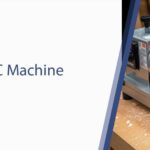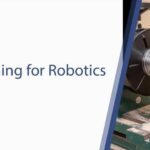In modern manufacturing, the journey from an initial idea to a precisely machined part is intricate, demanding both creativity and technical prowess.
At the heart of this journey lies CNC CAD CAM software, a powerful suite of digital tools that automates and optimizes every step of the production process.
This integrated technology is no longer a luxury; it’s a fundamental requirement for achieving the high precision, efficiency, and flexibility demanded by today’s competitive industries.
This comprehensive article will delve into the core functionalities, types, and benefits of CNC CAD CAM software, and how Radonix’s cutting-edge control solutions seamlessly integrate with this vital technology to bring your designs to life.
Why is Integrated CNC CAD CAM Software a Game-Changer for Manufacturing?
In an era where precision, speed, and cost-effectiveness define success, relying on manual processes for design and manufacturing is simply not sustainable.
CNC CAD CAM software provides the digital backbone that enables companies of all sizes to:
- Elevate Precision and Quality: By digitally defining every aspect of a part and its manufacturing process, CNC CAD CAM software eliminates human variability, leading to consistently higher precision, tighter tolerances, and superior surface finishes. This directly translates to fewer defects and higher-quality end products.
- Boost Efficiency and Reduce Lead Times: Automation of design, toolpath generation, and simulation dramatically reduces the time from concept to production. Optimized toolpaths and nesting strategies minimize material waste and machine runtime, significantly boosting overall efficiency and accelerating project delivery.
- Minimize Material Waste and Costs: Advanced nesting algorithms within the CAM component ensure that parts are arranged on raw material sheets in the most efficient way possible, drastically reducing scrap and saving on expensive materials.
- Enhance Design Complexity and Innovation: CNC CAD CAM software allows designers to create incredibly intricate and complex geometries that would be impossible or prohibitively expensive to produce using traditional methods. This fosters innovation and enables the creation of highly specialized components.
- Improve Collaboration and Communication: Digital models and manufacturing plans can be easily shared and reviewed across teams, departments, and even with clients, fostering better communication and reducing misunderstandings.
- Simulate and Validate Before Cutting: The ability to simulate the entire machining process virtually allows engineers and operators to identify potential collisions, inefficient cuts, or design flaws before any material is consumed. This prevents costly mistakes, saves valuable machine time, and enhances safety.
- Streamline Workflow Integration: When seamlessly integrated, CAD, CAM, and the CNC controller form a powerful digital thread that connects every stage of the manufacturing process, making the entire workflow more coherent and manageable.
Investing in CNC CAD CAM software isn’t just about acquiring tools; it’s about adopting a strategic approach to manufacturing that drives innovation, improves product quality, and significantly boosts your bottom line.
CAD, CAM, and CNC Control
The term CNC CAD CAM software refers to three interconnected but distinct stages of the manufacturing process. While often integrated into single software packages, understanding their individual roles is key:
1. CAD (Computer-Aided Design) Software: The Genesis of Your Vision
This is where the product design begins. CAD software allows engineers and designers to create virtual models of parts, assemblies, and products in a digital environment.
- Core Functionalities:
- 2D Sketching and Drafting: Creating precise two-dimensional drawings, defining profiles, dimensions, and geometric constraints. Essential for parts with flat surfaces or for defining the outline of a 3D model.
- 3D Modeling: Building three-dimensional representations of parts using various techniques like solid modeling, surface modeling, or direct modeling. This allows for full visualization of the part’s geometry.
- Assembly Design: Combining multiple individual part models into a virtual assembly to check for fit, interference, and functionality. This ensures all components work together as intended.
- Parametric Design: A powerful feature that allows design elements (like dimensions, features, and relationships) to be defined parametrically. Changes to one parameter automatically update the entire model, making design modifications quick and efficient.
- Drafting and Documentation: Generating technical drawings with dimensions, tolerances, and annotations for manufacturing and inspection purposes.
- Importance for CNC Machining: A precise CAD model is the foundation for accurate CNC machining. Any errors or ambiguities in the CAD model will be carried through to the manufacturing process, leading to flawed parts.
- Popular CAD Software: SolidWorks, AutoCAD, Inventor, Fusion 360, CATIA, Creo, SketchUp, FreeCAD.
- Radonix Relevance: Radonix CNC controllers are agnostic to the CAD software used. Our systems are designed to seamlessly accept the geometric data translated from any industry-standard CAD package through the CAM process.
2. CAM (Computer-Aided Manufacturing) Software: Bridging Design and Machine
CAM software translates the digital design from the CAD model into specific, actionable instructions (G-code) that a CNC machine can understand and execute.
This is where the manufacturing process is defined.
- Core Functionalities:
- Toolpath Generation: This is the most crucial function. CAM software calculates the precise path the cutting tool will follow to remove material from the raw stock, based on the part geometry, material, and selected tools. This includes various strategies like roughing, finishing, pocketing, drilling, profiling, and multi-axis operations.
- Tool Library Management: Storing and managing a comprehensive database of cutting tools, including their geometry (diameter, length, flute count), material, and recommended cutting parameters (feed rates, spindle speeds).
- Feed and Speed Optimization: Automatically calculating optimal feed rates and spindle speeds based on the material, tool, and desired surface finish to maximize efficiency and tool life.
- Nesting: A highly valuable feature, especially for sheet materials (like wood or sheet metal). Nesting algorithms optimize the layout of multiple parts on a single sheet to minimize material waste.
- Simulation and Verification: Virtually simulating the machining process to visualize tool movements, identify potential collisions between the tool, workpiece, and machine components, and check for any uncut material or excessive material removal. This prevents costly machine damage and scrap.
- Post-Processing: This is the final step in CAM. The generic toolpath data is converted into specific CNC G-codes that are tailored to the unique syntax and requirements of a particular CNC machine’s controller. This customization is vital for successful machine operation.
- Importance for CNC Machining: CAM software defines how the part will be manufactured. An inefficient or incorrect CAM program can lead to wasted material, longer cycle times, poor surface finish, or even machine damage.
- Popular CAM Software: Mastercam, GibbsCAM, Esprit, HSMWorks (integrated with SolidWorks), Fusion 360 (CAM module), VCarve, Aspire, Alphacam.
- Radonix Relevance: Our CNC controllers are engineered with advanced post-processor compatibility in mind. Radonix systems can flawlessly interpret the G-code generated by all leading CAM software solutions, ensuring your precisely calculated toolpaths are executed with the utmost accuracy and speed on your CNC machine.
3. CNC Control Software: The Machine’s Conductor
While not typically bundled with CAD/CAM as a single purchase, the CNC control software (which runs on the CNC machine’s controller, often a dedicated hardware unit from companies like Radonix) is the final link in the chain. It takes the G-code from the CAM software and directly commands the machine’s movements.
- Core Functionalities:
- G-code Interpretation and Execution: Reading the G-code line by line and translating it into electrical signals that drive the machine’s motors (stepper or servo), spindle, and other auxiliary functions.
- Real-time Monitoring: Displaying critical machine status, tool position (X, Y, Z coordinates), spindle speed, feed rate, and program progress to the operator.
- Machine Setup and Homing: Allowing operators to establish the machine’s home position and set workpiece offsets (where the program origin is relative to the material).
- Manual Control (Jogging): Enabling operators to manually move the machine’s axes for setup, inspection, or troubleshooting.
- Tool Management: Handling automatic tool changes (if the machine has this feature) and managing tool offsets (tool length and diameter compensation).
- Safety Interlocks and Emergency Stop (E-Stop): Implementing critical safety features that halt machine operation immediately in case of an emergency or detected fault.
- Error Handling and Alarms: Detecting and reporting machine errors or program faults.
- Importance for CNC Machining: This is the actual operational interface for the machine. A reliable and intuitive control software ensures smooth, safe, and efficient machining.
- Popular CNC Control Software: Mach3/Mach4, LinuxCNC, Grbl, Fanuc, Siemens Sinumerik, Heidenhain TNC, and Radonix’s proprietary CNC control software.
- Radonix Relevance: At Radonix, this is our core expertise. We design and manufacture robust CNC controllers and develop highly optimized control software that acts as the intelligent conductor for your CNC machine. Our CNC control software is tailored for:
- Unrivaled Precision and Speed: Translating G-code into incredibly accurate and fast machine movements.
- Exceptional Reliability: Engineered for continuous, demanding industrial environments, minimizing downtime.
- Intuitive User Interface: Designed to be user-friendly, reducing operator training time and potential errors.
- Broad G-code Compatibility: Our controllers can flawlessly execute G-code generated by the vast majority of CAM software solutions.
- Advanced Safety Features: Prioritizing the safety of both operators and machinery with comprehensive interlocking and emergency protocols.
- Robust Diagnostic Tools: Providing clear feedback for troubleshooting and maintenance.
Key Features to Look for in Integrated CNC CAD CAM Software
When evaluating a comprehensive CNC CAD CAM software solution, consider these essential features:
- Seamless Integration: The ideal solution offers tight integration between CAD and CAM modules, allowing for easy transitions from design to toolpath generation without data loss or conversion issues.
- User-Friendly Interface: An intuitive and well-organized interface across both CAD and CAM modules reduces the learning curve and boosts productivity for designers and programmers.
- Comprehensive Tool Libraries: A robust tool library that allows for custom tool definitions and automatic parameter adjustments based on material and tool type.
- Advanced Toolpath Strategies: Look for a variety of toolpath options (e.g., adaptive clearing, roughing, finishing, pocketing, drilling, 3D carving) to suit diverse machining needs.
- Efficient Nesting Algorithms: For sheet-based manufacturing, intelligent nesting is crucial for minimizing material waste and maximizing yield.
- Realistic Simulation & Verification: High-fidelity simulation that accurately represents material removal, tool movement, and collision detection is vital for preventing costly errors.
- Customizable Post-Processors: The ability to generate G-code specifically tailored to your CNC machine’s controller (like Radonix controllers) is non-negotiable. Ensure the software offers or supports the creation of the correct post-processor for your setup.
- Material and Machining Data Libraries: Pre-populated or customizable libraries with recommended cutting parameters for different materials and tools can significantly speed up programming.
- Error Handling and Diagnostics: Software that provides clear error messages and diagnostic tools for both design and machining processes.
- Scalability and Future-Proofing: Can the software handle increasingly complex designs or multi-axis machining if your production needs grow? Does it receive regular updates with new features and compatibility?
- Technical Support and Community: Access to reliable technical support and an active user community can be invaluable for troubleshooting and learning.
The Transformative Impact of CNC CAD CAM Software on Manufacturing Workflows
The synergistic power of CNC CAD CAM software transforms traditional manufacturing workflows into highly efficient digital pipelines:
- Accelerated Prototyping: Rapidly move from a design concept to a physical prototype, allowing for quick iterations and faster product development cycles.
- Reduced Manual Intervention: Automating complex calculations and movements frees up human operators to focus on supervision, quality control, and strategic tasks rather than repetitive manual operations.
- Enhanced Repeatability: Once a G-code program is generated and validated, it can be run countless times with consistent results, ensuring high repeatability and uniformity in mass production.
- Cost Efficiency: Through material optimization, reduced machining time, lower scrap rates, and minimized human error, CNC CAD CAM software directly contributes to significant cost savings.
- Competitive Edge: Companies leveraging integrated CNC CAD CAM software can offer more complex products, faster turnaround times, and higher quality, gaining a significant competitive advantage in the market.
Radonix controllers are specifically engineered to harness the full potential of these digital manufacturing pipelines. Our systems are built to process the sophisticated G-code generated by advanced CAD/CAM software, delivering the precision and performance your operations demand.
Radonix and Your CNC CAD CAM Software Ecosystem
At Radonix, we recognize that our CNC control systems are a critical component within a larger CNC CAD CAM software ecosystem. Our commitment is to ensure seamless interoperability and maximum performance within this ecosystem.
- Universal G-code Interpretation: Our controllers are designed to interpret standard G-code generated by virtually all major CAM software packages. This means you have the flexibility to choose the CAD/CAM solution that best fits your design and programming needs, confident that a Radonix controller will execute it flawlessly.
- High-Speed Processing: We understand that modern CAM software generates increasingly complex toolpaths with many short line segments. Radonix controllers are optimized for high-speed processing, ensuring smooth, continuous motion even with intricate G-code, preventing stuttering or loss of accuracy.
- Reliability and Stability: Our hardware controllers are built with industrial-grade components and robust design principles to ensure stability and reliability in demanding manufacturing environments, providing a stable platform for your CNC CAD CAM software output.
- Intuitive Control Interface: While CAM handles the complex calculations, our accompanying CNC control software provides a clear, user-friendly interface for loading programs, monitoring progress, and interacting with the machine, making the overall workflow efficient.
- Dedicated Support: When you choose Radonix, you gain a partner. Our expert technical support team is available to assist with integration, setup, and any questions related to running G-code generated by your CNC CAD CAM software on our controllers. Visit radonix.com for comprehensive support resources.
The Future of CNC CAD CAM Software
The evolution of CNC CAD CAM software is relentless, with future developments promising even greater automation, intelligence, and integration:
- AI-Powered Design and Optimization: AI will increasingly assist in generative design, automatically creating optimized part geometries based on functional requirements. AI will also refine toolpaths, predict tool wear, and suggest optimal machining strategies.
- Cloud-Native Platforms: More CNC CAD CAM software will move to cloud-based platforms, enabling remote collaboration, real-time data analysis, and seamless access from any device.
- Digital Twins and Simulation: The creation of “digital twins” – virtual replicas of physical machines and processes – will allow for even more accurate simulations, predictive maintenance, and real-time optimization of manufacturing operations.
- Automated Quality Control: Integration of metrology (measurement) devices directly into the CAD/CAM/CNC loop will enable automated in-process quality control, with feedback loops to adjust machining parameters.
- Advanced Robotics Integration: CNC CAD CAM software will simplify the programming and control of multi-axis robots for complex manufacturing tasks, extending beyond traditional Cartesian CNC.
- Adaptive Machining: Systems will dynamically adjust cutting parameters in real-time based on sensor feedback (e.g., force, vibration), compensating for material variations or tool deflection to maintain optimal quality.
Radonix is committed to staying at the forefront of these advancements, ensuring our CNC control solutions are ready to integrate with and leverage the cutting-edge capabilities of future CNC CAD CAM software.
Conclusion
CNC CAD CAM software is the undisputed cornerstone of modern manufacturing.
It is the sophisticated ecosystem that transforms abstract ideas into tangible, high-precision components, driving efficiency, quality, and innovation.
From the initial spark of design in CAD to the meticulously calculated toolpaths in CAM, and finally, to the precise execution by the CNC controller, this integrated technology empowers manufacturers to achieve unprecedented levels of productivity and complexity.
At Radonix, we understand this intricate relationship.
Our CNC control systems are engineered to be the robust, reliable, and intelligent interpreters of the G-code generated by your CNC CAD CAM software, ensuring that your digital designs are flawlessly translated into physical reality.
We are dedicated to providing the foundational control technology that allows your CAD/CAM investment to truly shine.
Discover how Radonix solutions can enhance your manufacturing workflow. Visit radonix.com for more information and to connect with our expert team.
Contact Us:
- E-Mail: info@radonix.com
- Phone: +90 (553) 920 5500








